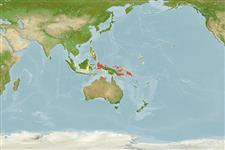>
Blenniiformes (Blennies) >
Blenniidae (Combtooth blennies) > Blenniinae
Etymology: Meiacanthus: Greek, meion = less = lessen + Greek, akantha = thorn (Ref. 45335); crinitus: Specific epithet means 'hairy', referring to the elongate inner caudal-fin rays which distinguish the adult males..
Environment: milieu / climate zone / depth range / distribution range
Ekologi
laut dasar (demersal); kisaran kedalaman 0 - 20 m (Ref. 90102). Tropical
Western Central Pacific: Indonesia.
Size / Weight / umur
Maturity: Lm ? range ? - ? cm
Max length : 10.0 cm TL jantan/; (Ref. 48636)
deskripsi pendek
Morfologi | Morfometrik
Males with long filament extending from one or two rays of the tail (Ref. 48636).
A shallow water species, forming small aggregations in well protected narrow bays or inlets. Usually in sponge habitats (Ref. 48636). Adults may be found solitary or in pairs (Ref. 90102). Oviparous. Eggs are demersal and adhesive (Ref. 205), and are attached to the substrate via a filamentous, adhesive pad or pedestal (Ref. 94114). Larvae are planktonic, often found in shallow, coastal waters (Ref. 94114). Mimics the young of Pentapodus trivittata (Ref. 90102). Minimum depth of 0 m reported from Ref.7401.
Oviparous, distinct pairing (Ref. 205).
Smith-Vaniz, W.F., 1987. The saber-toothed blennies, tribe Nemophini (Pisces: Bleniidae): an update. Proc. Acad. Nat. Sci. Philad. 139:1-52. (Ref. 7401)
Status IUCN Red List (Ref. 130435)
ancaman kepada manusia
Harmless
penggunaan manusia
informasi lanjut
Umur / SaizPertumbuhanpanjang-beratpanjang-panjangukuran frekuensiMorfometrikMorfologiLarvaDinamika larvapemulihanKelimpahanBRUVS
AcuanBudidaya airprofil budidaya airStrainGenetikaElectrophoresesDiturunkanPenyakit-penyakitPengolahanNutrientsMass conversion
mitraGambarStamps, Coins Misc.Suara-suaraCiguateraKecepatanTipe renangArea insangOtolithsOtakPenglihatan / visi
Alat, peralatan
laporan khas
muat turun XML
Sumber internet
Estimates based on models
Preferred temperature (Ref.
123201): 28.8 - 29.3, mean 29 °C (based on 262 cells).
Phylogenetic diversity index (Ref.
82804): PD
50 = 0.5000 [Uniqueness, from 0.5 = low to 2.0 = high].
Bayesian length-weight: a=0.01122 (0.00514 - 0.02450), b=3.04 (2.87 - 3.21), in cm total length, based on all LWR estimates for this body shape (Ref.
93245).
Trophic level (Ref.
69278): 3.4 ±0.4 se; based on size and trophs of closest relatives
Daya lenting (Ref.
120179): Tinggi, Waktu penggandaan populasi minimum kurang dari 15 bulan (Preliminary K or Fecundity.).
Fishing Vulnerability (Ref.
59153): Low vulnerability (10 of 100).
Nutrients (Ref.
124155): Calcium = 350 [212, 841] mg/100g; Iron = 1.86 [1.13, 3.25] mg/100g; Protein = 17.7 [16.7, 18.6] %; Omega3 = 0.23 [0.13, 0.42] g/100g; Selenium = 32.8 [16.2, 73.0] μg/100g; VitaminA = 53.7 [16.9, 170.2] μg/100g; Zinc = 2.07 [1.37, 3.05] mg/100g (wet weight);
